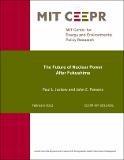| dc.contributor.author | Joskow, Paul L. | |
| dc.contributor.author | Parsons, John E. | |
| dc.date.accessioned | 2012-05-16T20:59:03Z | |
| dc.date.available | 2012-05-16T20:59:03Z | |
| dc.date.issued | 2012-02 | |
| dc.identifier.uri | http://hdl.handle.net/1721.1/70857 | |
| dc.description | http://web.mit.edu/ceepr/www/publications/workingpapers.html | en_US |
| dc.description.abstract | This paper analyzes the impact of the Fukushima accident on the future of nuclear
power around the world. We begin with a discussion of the ‘but for’ baseline and the
much discussed ‘nuclear renaissance.’ Our pre-Fukushima benchmark for growth in
nuclear generation in the U.S. and other developed countries is much more modest than
many bullish forecasts of a big renaissance in new capacity may have suggested. For at
least the next decade in developed countries, it is composed primarily of life extensions
for many existing reactors, modest uprates of existing reactors as their licenses are
extended, and modest levels of new construction. The majority of forecasted new
construction is centered in China, Russia and the former states of the FSU, India and
South Korea. In analyzing the impact of Fukushima, we break the effect down into two
categories: the impact on existing plants, and the impact on the construction of new units.
In both cases, we argue that the accident at Fukushima will contribute to a reduction in
future trends in the expansion of nuclear energy, but at this time these effects appear to be
quite modest at the global level. | en_US |
| dc.language.iso | en_US | en_US |
| dc.publisher | MIT CEEPR | en_US |
| dc.relation.ispartofseries | CEEPR Working Papers;2012-001 | |
| dc.rights | An error occurred on the license name. | en |
| dc.rights.uri | An error occurred getting the license - uri. | en |
| dc.title | The Future of Nuclear Power After Fukushima | en_US |
| dc.type | Working Paper | en_US |
| dc.identifier.citation | WP-2012-001 | en_US |
